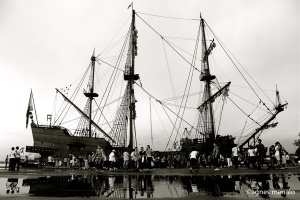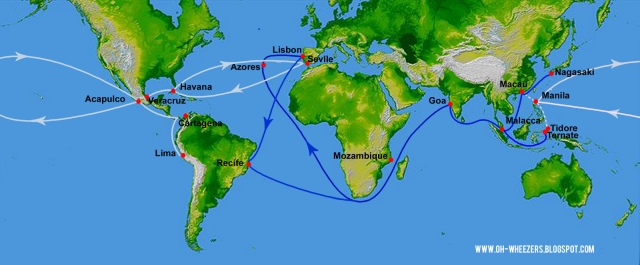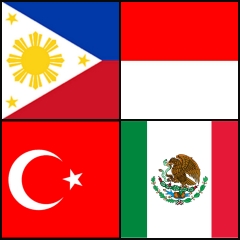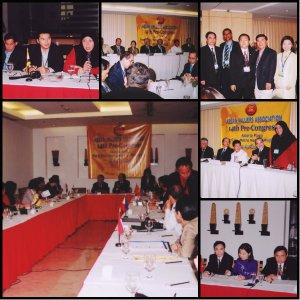The Philippines plays a vital role in the formation, implementation and sustainability of the new emerging economic block of the ASEAN.
With a rich historical, cultural and social interaction of several racial groups, the Philippines is considered unique in many ways, thus benefiting the economic backbone of the nation. The “melting pot” of cultures, races, people and economic activity.
The dynamic mix of a basic Malay race, with several Indigenous Native tribes, intertwined with Chinese traders, colonized by Spain for 300 years, and further enhanced by an American education and political structure, the Philippine archipelago is united by 7,107 islands into one nation.
Historically, the Philippines proved its economic strength during the glorious decades of the Manila Galleon (1565-1815). The Galleons were Spanish ships that sailed sailed once or twice per year across the Pacific Ocean between Manila in Spanish East Indies (present day-Philippines), and Acapulco, New Spain (present-day Mexico).
Because of the harsh route, the Galleon Years also saw the devotion to the “Queen of the Galleons”, Nuestra Señora de la Soledad de Porta Vaga in which voyagers will pay homage everytime they had a successful voyage and offer gold and other precious gems.
One may say that the Philippines was indeed the first in global trade via the Pacific, moving goods from Asia, China, the Southern Islands of Malaysia and Indonesia to Southern America and Europe.
The Philippines was then the Gateway to Asia, China and the South East Asian Nations, and today, after a century, and in this new millennium, the Philippines will once more most likely be the Star and Pearl of the Orient.
Being in the crossroads and gateway of the ASEAN Region, the Philippines plays an important strategic location for trade and industry.
During the Standard Chartered’s Singapore Forum, Finance Secretary Cesar V. Purisima said, “We in the Philippines look forward to ASEAN integration in 2015. Our hope is that the Philippines will be the Northern and Pacific gateway to ASEAN.”
Therefore, as reported by B.F.V. Roc of Business World (March 27, 2013), “The Aquino administration is committed to ensure that we continue to invest in infrastructure, our people, and address the constraints to growth.”
The Philippines was once called as the “Sick Man of Asia” before. Until it become “A Tiger Cub of Asia” when economists discover that growth is now beginning to unfold. Until 2012, when the country recorded a 6% growth, the second highest growth in Asia, President Aquino announced that the Philippines is no longer the “Sick Man of Asia”.
And recently, as predicted by international economists including world-renowned, Nouriel Roubini, the Philippines successfully granted an investment grade by Fitch and Ratings. Roubini, in his Twitter account, said “As I predicted in Manila in early February the Philippines was upgraded by Fitch to an investment grade rating. A well deserved upgrade!”
Soon, other groups such as Standard and Poor, the first to hint of an upgrade when it issued a “positive” outlook on its rating, are seen to grant the country the same recognition.
With this investment grade rating, the country is now “The Rising Tiger of Asia.”
In the article of Philippine Daily Inquirer, DILG Secretary Mar Roxas said that the investment grade “reflects the Philippines’ good fundamentals arising from President Benigno Aquino III’s leadership, enabling takeoff. Our challenge now is to ramp up to cruising altitude, so that we could soar higher.”
In the same article, Senator Loren Legarda also added that “we are the great survivor of the financial crisis which hit Europe and other Asian countries. This impetus will lead to sustainable and inclusive growth, thanks to the cooperation of both houses of Congress with the good governance policies of President Aquino.”
With this investment grade rating, we can see the Philippines to perform well in the 2015 ASEAN Integration.
The demographic, and population strength of the ASEAN nations places the region in a very strategic position for economic activity, market demand and development.
The unity of these nations in the ASEAN is rooted in common cultural, social and historical past with diverse individual competences, yet in a harmonious strength and sharing the same vision and goal of economic integration and cooperation.
Initiatives towards the creation of an ASEAN Economic Community include the lowering of trade barriers, capital markets, integration and greater information sharing, among others.
Aside from ASEAN Integration, the Philippines together with other “new emerging rising stars” Turkey, Indonesia and Mexico are discussing the possibility of creating an informal coalition similar to BRICS (Brazil, Russia, India, China and South Africa) that will create progress in their international interests.
In the article of Conrad De Aenlle (Thru GMA 7 News), Bob Turner, the Chief Investment Officer of Turner Investment Partners, said that what made TIMP countries stand out “is that they possess qualities that should keep them and their stock markets expanding rapidly and profitably. These include favorable demographics and strengthening economies and political institutions.”
The ASEAN and TIMP opportunities will also play a vital role in the real estate industry. For ASEAN, we already have the ASEAN Valuers Association. With the AEC, Filipino Real Estate professionals can expect to work hand-in-hand with other Real Estate professionals in ASEAN countries. Recently, the 1st Asia Pacific Real Estate Convention and Expo (APRECE) 2013 were held at Marina Bay Sands in Singapore. 15 cooperating real estate associations from Asia learned and explored about Real Estate skills from international speakers and from 1000 real estate professionals composing of realtors, developers, architects, consultants, and marketing tools providers.
The Philippines has the most number of delegates, clearly showing the Filipino Real Estate Professionals willingness to be globally competitive. This is one of the examples on how ASEAN Real Estate professionals can work hand-in-hand.
During the Sectoral Meeting with representatives from different Real Estate organizations, associations, and individuals last November 6 2012, Professional Regulation Commission Chairperson, Teresita Manzala met with the Real Estate practitioners, urging them to integrate and unify. She stressed the need for them to develop, educate, train, and be internationally competent.
She warned them to prepare for the new Trade and Business Agreement with the ASEAN by 2015 whereby the Philippines will open its boundaries with our ASEAN Real Estate Professionals. With this scenario and situation, global competition will demand and call for all Filipino Real Estate practitioners be equip with International best practices, governance, and prestigious professional competence.
“As the ASEAN unity progresses towards a single market, it is imperative that we assist each other in the development of each member-country. We have observed that the share of Foreign Direct Investments in the ASEAN was dismal compared to the larger economies in Asia. And a professional appraisers, valuers and assessors, we have the duty to contribute our share in the development and promotion of the structure needed for cross-broader investments,” ASEAN Valuers Association President, Federico Cuervo said.
The late Ramon Cuervo Jr., one of the AVA Co-founders, said that “The prevailing spirit of trusts and mutual respect towards one another has fostered a unity towards achieving the principal aim and purpose of AVA- that of attaining an economic and social betterment for our respective citizenry.”
The elder Cuervo, who was also the former AVA President, said that AVA members should continue to pursue and intensify their efforts to ensure qualitative improvements in their intra-ASEAN members through achieving professional standards and that it is their collective desire to establish a broader dialogue – relationship with institutions and /or associations of their kind in developed countries, particularly the Asia Pacific region in order to promote a mutual beneficial relationship.
He assured that “The years ahead will be challenging, yet undoubtedly promising and fruitful, if we (AVA members) cohesively strive to attain our goals.”
According to Mr. Ramon CF Cuervo III, there are really endless opportunities for real estate industry in ASEAN. But this must fit one like a glove or a shoe. “Our field of specialization will develop in time, after years of practice then we will earn that prestige, good reputation, and develop a brand name or create an international institution in real estate. Yes, the Filipino can! The Filipino in essence is international, of Malay race, Spanish – Chinese cultural roots, and American education,” he said.
“To conclude, we Professional Real Estate Practitioners of the Philippines are destined for greater heights, to renew our once number one position in Asia, not just because of the old Manila Galleon Trade, but because our professionals are indeed outstanding in all the corners of the globe.”
With the Philippines as a member of 2015 ASEAN Integration and TIMP, we can expect melting pot of different cultures all with one mission- countries helping and working together as a family.
Source: http://cuervopropertyadvisory.wordpress.com/2013/04/02/philippines-economic-melting-pot-and-gateway-of-the-asean/





No comments:
Post a Comment